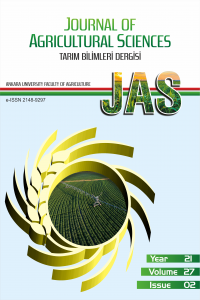Comparison of Physicochemical Attributes of Einkorn Wheat (Triticum monococcum) and Durum Wheat (Triticum durum) and Evaluation of Morphological Properties Using Scanning Electron Microscopy and Image Analysis
Comparison of Physicochemical Attributes of Einkorn Wheat (Triticum monococcum) and Durum Wheat (Triticum durum) and Evaluation of Morphological Properties Using Scanning Electron Microscopy and Image Analysis
Siyez, einkorn, Triticum monococcum durum wheat, image analys,
___
- AACC (2000). Approved methods of the American Association of Cereal Chemists, 8th edn. AACC International, St. Paul
- AOAC (1995). Official Method 985.29, Total Dietary in Foods—Enzymatic-Gravimetric Method. Official Methods of Analysis, 16th ed. AOACInternational, Gaithersburg, MD.
- Andersson AA, Andersson R, Piironen V, Lampi AM, Nyström L, Boros D, Fraś A, Gebruers K, Courtin CM, Delcour JA, Rakszegi M, Bedo Z, Ward JL, Shewry PR & Man P (2013). Contents of dietary fibre components and their relation to associated bioactive components in whole grain wheat samples from the HEALTH GRAIN diversity screen Food Chemistry 136:1243–1248
- Banu I, Vasilean I & Aprodu I (2010). Effect of lactic fermentation on antioxidant capacity of rye sourdough and bread. Food Science and Technology Research 16: 571 – 576.
- Borghi B, Castagna R, Corbellini M, Heun M & Salamini F (1996). Breadmaking quality of einkorn wheat (Triticum monococcum ssp. monococcum). Cereal Chemistry 73:208–214
- Delcour JA & Hoseney RC (2010). Principles of cereal science and technology. St. Paul, MN, USA: AACC International.
- Gebruers K, Dornez E, Boros D, Fra A, Dynkowska W, Bedo Z, Rakszegi M, Delcour JA & Courtin CM (2008). Variation in the content of dietary fiber and components thereof in wheats in the HEALTHGRAIN diversity screen. Journal of Agricultural Food Chemistry 56: 9740–9749
- Giuliani A, Karagöz A & Zencirci N (2009). Emmer (Triticum dicoccon) Production and market potential in marginal mountainous areas of Turkey. Mountain Research and Development 29(3):220-229
- Grausgruber H, Scheiblauer J, Schonlecher R, Ruckenbauer P & Berghofer E (2004). Variability in chemical composition and biologically active constituents of cereals, in Genetic Variation for Plant Breeding: Proceedings of the 17th EUCARPIA General Congress, ed. by Vollman J, Grausgruber H and Ruckenbauer P. BOKU – University of Natural Resources and Applied Life Sciences, Vienna, pp. 23–26.
- Heun M, Schaefer-Pregl R, Klawan D, Castagna R, Accerbi M, Borghi B & Salamini F (1997). Site of einkorn wheat domestication identified by DNA fingerprinting. Science 278:1312–1314
- Hidalgo A & Brandolini A (2014). Nutritional properties of einkorn wheat (Triticum monococcum L.). Journal of the Science of Food and Agriculture 94: 601–612
- Karamach M, Amarowicz R, Weidner S, Abe S & Shahidi F (2002). Antioxidant Activity of rye caryopses and embryos extracts, Czech Journal of Food Science 20: 209–214.
- Kilci A & Gocmen D (2014). Changes in antioxidant activity and phenolic acid composition of tarhana with steel-cut oats. Food Chemistry 145:777–783
- Lev-Yadun S, Gopher A & Abbo S (2000). The cradle of agriculture. Science 288: 1602-1603.
- Løje H, Møller B, Laustsen AM & Hansen A (2003). Chemical composition, functional properties and sensory profiling of einkorn (Triticum monococcum L.). Journal of Cereal Science 37:231–240
- Ozkan H, Brandolini A, Torun A, Altintas S, Eker S, Kilian B, Braun HJ, Salamini F & Cakmak I (2007). Natural variation and identification of microelements content in seeds of einkorn wheat (Triticum monococcum), in Wheat Production in Stressed Environments. Proceedings of the 7th International Wheat Conference, ed. by Buck HT, Nisi JE and Salom´on N. Springer, New York, NY, pp. 455–462
- Piperno DR, Weiss E, Holst I & Nadel D (2004). Processing of wild cereal grains in the upper palaeolithic revealed by starch grain analysis. Nature 430:670-673
- ISSN: 1300-7580
- Yayın Aralığı: Yılda 4 Sayı
- Başlangıç: 1995
- Yayıncı: Ankara Üniversitesi
Use of Principal Coordinate Analysis for Measuring GE Interactions in Rain-Fed Durum Wheat Genotypes
Ali Asghari, Rahmatollah Karimizadeh, Rahim Chinipardaz, Omid Sofalian, Abdolali Ghaffari, Kamal Shahbazi, Tahmasb Hosseinpour, Hassan Ghojog, Mohammad Armion
Khadijah MAKHDOOM, Naqib Ullah KHAN, Shahid Ullah KHAN, Rozina GUL, Zarina BIBI, Samrin GUL, Sardar ALI, Shah Masaud KHAN, Naushad ALI
Behnam FİROOZİ, Nasser ZARE, Omid SOFALİAN, Parisa SHEİKHZADE-MOSADEGH
Anatomical Analysis of Graft Compatibility in Some Almond ScionRootstock Combination
Başak Özdemir, Ajlan YILMAZ, Hatice Nurhan BÜYÜKKARTAL, Yeşim OKAY
Fatemeh BAREKATİ, Eslam MAJİDİ HERVAN, Amir Hossein SHİRANİ RAD, Ghorban NOOR MOHAMADİ
Jale KORUN, Mesut YILMAZ, Mehmet GÖKOĞLU, Yağmur ÇELİK
Arzu ÇELİK OĞUZ, Amir RAHİMİ, Aziz KARAKAYA
Production of Double Haploid Plants Using In Vivo Haploid Techniques in Corn
İlhan TURGUT, 2. duran ZARARSIZ, 3. semra YANIKOĞLU, 4. leyla ÖZTÜR AKAR, 5. sezgin KIZIK, 6. burak BİLGİN
